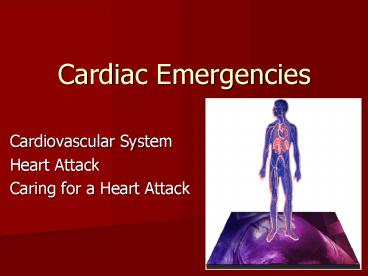Cardiac Emergencies PowerPoint PPT Presentation
1 / 33
Title: Cardiac Emergencies
1
Cardiac Emergencies
- Cardiovascular System
- Heart Attack
- Caring for a Heart Attack
2
Cardiovascular System
- Heart-muscular organ that pumps blood (about the
size of your fist) - Blood- carries oxygen nutrients
3
Arteries
Carry oxygen- rich blood AWAY from the heart.
4
Veins
- Carry oxygen-
- poor blood
- back to the heart.
5
Coronary Arteries
- Supply the heart
- muscle with blood
6
Heart Attack
When the heart muscle doesnt receive oxygen,
that part of the muscle dies and causes CHEST
PAIN!
7
Common cause of Heart Attack
- Cardiovascular Disease
- Leading cause of death for adults in the United
States - Nearly 1 million deaths each year
8
Signs and Symptoms of a Heart Attack
-Chest pain (1) -Pressure, squeezing or
tightness -Difficulty breathing -Sweating -Nausea
or vomiting -Pale, bluish or moist skin -Changes
in pulse rate
9
Heart Attack Victims
- Victims often deny that they are having a heart
attack or dismiss the pain as indigestion - Do NOT let this influence youif you think the
victim is having a heart attack you must act
FAST. - Prompt action may prevent cardiac arrest
10
Heart Attack
- Pain or discomfort in the chest that lasts more
than 3-5 minutes or that goes away and comes back
11
Risk factors for Cardiovascular Disease
- Smoking
- Poor diet (high in fat)
- High blood pressure
- Obesity
- Lack of regular exercise
12
Risk Factors
13
HYPERTENSION
- High Blood
- Pressure
14
Measures High Blood Pressure
- Sphygmomanometer
15
Blood Pressure
- Normal- 120/80
- 120 pressure of blood against the artery walls
when the heart beats - -- 80 pressure between beats
16
Blood Pressure Values
- Normal. Less than 120/80
- Hypertension. 140/90
17
Increase in High Blood Pressure
18
Causes of HBP
- Genetics
- Obesity
- Lack of physical activity
- Too much salt in the diet
- Too much alcohol consumption (no more than 1 to 2
drinks per day) - Stress
19
Wheres the SALT?
- Contain high levels of sodium (salt)
- Lunch meats
- Soy sauce
- Canned soups and canned vegetables
- Frozen dinners
- Pickles
- Chinese food
- Potato chips, corn chips
20
Symptoms of HBP
- There are NO symptoms or signs of hypertension,
so you usually don't feel it. - In fact, nearly 1/3 of those who have
hypertension don't know it. The only way to know
if you have hypertension is to have your blood
pressure checked.
21
Health problems associated with HBP
- Stroke
- Heart failure/attack
- Sleep apnea/snoring
- Kidney failure
- Vision problems
- Premature death
- Erectile dysfunction
- baldness
22
Reducing the risks
- Eat more fruits and veggies
- Lower salt intake (1 tsp a day)
- Exercise at least 30 minutes a day
- Moderate alcohol consumption (no more than 2
drinks a day) - Maintain healthy weight
23
Cholesterol
HDL and LDL HDL good LDL bad
24
LDL- Bad cholesterol
- Too much LDL in the blood causes a build up
25
What LDL does
- it can slowly build up in the inner walls of the
arteries that feed the heart and brain, forming
plaque, a thick, hard deposit that can clog those
arteries
26
ATHEROSCLEROSIS
- This condition is known as atherosclerosis. If a
clot forms and blocks a narrowed artery, it can
cause a heart attack or stroke.
27
HDL- Good cholesterol
- HDL cholesterol is known as the "good"
cholesterol - HDL tends to carry cholesterol away from the
arteries and back to the liver, where it's passed
from the body.
28
Increasing your HDLs
- Increase the monounsaturated fats in your diet.
- canola oil, avocado oil, or olive oil and in the
fats found in peanut butter - Add soluble fiber to your diet.
- oats, fruits, vegetables, and legumes
- at least two servings a day
29
What NOT to eat
- Saturated fatty acids - which come from animal
fats (meat, lard, dairy products) and tropical
oils such as coconut and palm oils - raise the
levels of LDL cholesterol.
30
NO GOOD FOR YOU
- stick margarines contain the most trans fatty
acid, tub margarines contain less, and
semi-liquid margarines contain the least
31
Obesity Hazards
- Risk of strokes, diabetes, heart disease, HBP
- Appendicitis
- Arthritis
- Hernia
32
Need to change our Lifestyle
- 2/3 of Americans are overweight
33
Get Healthy NOW
- Cardiovascular disease develops gradually, over
many years - Leading a healthy lifestyle now is important for
future health

